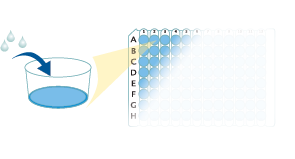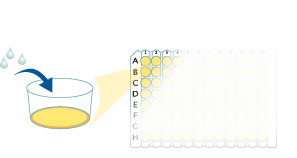Mouse CD14 Quantikine ELISA Kit Summary
Product Summary
Precision
Cell Culture Supernates, Serum, EDTA Plasma, Heparin Plasma
| Intra-Assay Precision | Inter-Assay Precision | |||||
|---|---|---|---|---|---|---|
| Sample | 1 | 2 | 3 | 1 | 2 | 3 |
| n | 20 | 20 | 20 | 20 | 20 | 20 |
| Mean (pg/mL) | 177 | 486 | 1425 | 158 | 433 | 1416 |
| Standard Deviation | 6.3 | 13.7 | 85.5 | 13.9 | 28.2 | 95 |
| CV% | 3.6 | 2.8 | 6 | 8.8 | 6.5 | 6.7 |
Recovery
The recovery of mouse CD14 spiked to three levels throughout the range of the assay was evaluated.
| Sample Type | Average % Recovery | Range % |
|---|---|---|
| Cell Culture Samples (n=4) | 97 | 87-107 |
Linearity
Scientific Data
Product Datasheets
Preparation and Storage
Background: CD14
CD14 is an acute phase glycoprotein that binds lipopolysaccharide (LPS) endotoxins with cells, thereby signaling the presence of gram-negative bacteria (1-4). Its 11 leucine-rich repeats mediate the interaction with LPS. The 55 kDa form, mCD14, is anchored to the membrane via glycosylphosphatidylinositol (GPI) linkage (1, 2, 5-7). Human mCD14 shares 63-73% amino acid sequence identity with mouse, rat or rabbit CD14. Soluble forms of CD14, or sCD14, may be secreted prior to GPI linkage or shed by proteolysis or cleavage of the GPI linkage. This variation, plus variable glycosylation, creates forms that may range from 43 to 53 kDa (8-10). In humans, the N terminal 13 kDa, termed presepsin or sCD14-ST, is a small soluble subtype that is found in plasma during sepsis or local infection (11-13). Membrane CD14 is expressed primarily on the cells that are most sensitive to LPS, including monocytes, macrophages and neutrophils (1-3). Lower amounts are detected on other cells, such as B cells, epithelial cells, endothelial cells, and fibroblasts (1, 14-16). Soluble CD14 is found in serum, urine and other body fluids (5).
Assay Procedure
Refer to the product- Prepare all reagents, standard dilutions, and samples as directed in the product insert.
- Remove excess microplate strips from the plate frame, return them to the foil pouch containing the desiccant pack, and reseal.
- Add 100 µL of Assay Diluent to each well.
- Add 50 µL of Standard, control, or sample to each well. Cover with a plate sealer, and incubate at room temperature for 2 hours on a horizontal orbital microplate shaker.
- Aspirate each well and wash, repeating the process 3 times for a total of 4 washes.
- Add 100 µL of Conjugate to each well. Cover with a new plate sealer, and incubate at room temperature for 2 hours on the shaker.
- Aspirate and wash 4 times.
- Add 100 µL Substrate Solution to each well. Incubate at room temperature for 30 minutes on the benchtop. PROTECT FROM LIGHT.
- Add 100 µL of Stop Solution to each well. Read at 450 nm within 30 minutes. Set wavelength correction to 540 nm or 570 nm.





Citations for Mouse CD14 Quantikine ELISA Kit
R&D Systems personnel manually curate a database that contains references using R&D Systems products. The data collected includes not only links to publications in PubMed, but also provides information about sample types, species, and experimental conditions.
4
Citations: Showing 1 - 4
Filter your results:
Filter by:
-
Development of a newly immunoassay specific for mouse presepsin (sCD14-ST)
Authors: G Takahashi, K Hoshikawa, R Suzuki, K Sato, S Hoshi, D Yoshinao, K Shirakawa
Scientific Reports, 2022-12-15;12(1):21724.
Species: Mouse
Sample Types: Plasma
-
The transcription factor LRF promotes integrin beta7 expression by and gut homing of CD8alphaalpha+ intraepithelial lymphocyte precursors
Authors: J Nie, AC Carpenter, LB Chopp, T Chen, M Balmaceno-, T Ciucci, Q Xiao, MC Kelly, DB McGavern, Y Belkaid, R Bosselut
Nature Immunology, 2022-03-30;23(4):594-604.
Species: Mouse
Sample Types: Serum
-
A human-origin probiotic cocktail ameliorates aging-related leaky gut and inflammation via modulating microbiota-taurine-tight junction axis
Authors: S Ahmadi, S Wang, R Nagpal, B Wang, S Jain, A Razazan, SP Mishra, X Zhu, Z Wang, K Kavanagh, H Yadav
JCI Insight, 2020-05-07;0(0):.
Species: Mouse
Sample Types: Serum
-
CD14 Plays a Protective Role in Experimental Inflammatory Bowel Disease by Enhancing Intestinal Barrier Function
Authors: S Buchheiste, M Buettner, M Basic, A Noack, G Breves, B Buchen, LM Keubler, C Becker, A Bleich
Am. J. Pathol., 2017-04-12;0(0):.
Species: Mouse
Sample Types: Tissue Homogenates
FAQs
No product specific FAQs exist for this product, however you may
View all ELISA FAQsReviews for Mouse CD14 Quantikine ELISA Kit
Average Rating: 5 (Based on 1 Review)
Have you used Mouse CD14 Quantikine ELISA Kit?
Submit a review and receive an Amazon gift card.
$25/€18/£15/$25CAN/¥75 Yuan/¥2500 Yen for a review with an image
$10/€7/£6/$10 CAD/¥70 Yuan/¥1110 Yen for a review without an image
Filter by:










